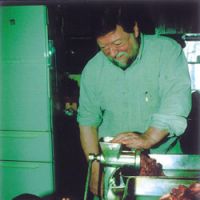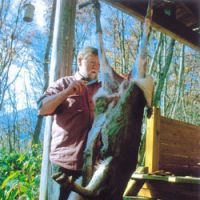We were filming a television documentary in the mountains of Hokkaido. It was winter, and bitterly cold. Through the trees, bare of leaves, we could see floe ice, dotted with eagles, gulls, crows and a few ravens. Then a raucous gathering of crows ahead drew our attention and we trudged through the crisp snow to see what the fuss was about.
What we found was the frozen, mutilated carcass of a stag, which had been killed by a rifle bullet. This I could tell by the exit wound in its chest, which was ragged, and about 7 cm in diameter. The crows and other birds had been pecking at this, but also at other long wounds on the animal's back, where strips of skin and muscle had been cut away, and at wounds on the stag's rump where haunch meat had been cut away, leaving the bones and the sinewy muscles of the leg exposed above the hooves.
It wasn't long before we found two other carcasses, both similarly shot and stripped of just the easiest and most tender meat to get at.
This was in a supposedly protected area of a national park. The shooting had not been a part of an official cull. There would be no data on these dead deer. This was the work of poachers — but why had they shot these animals?
Quite simply, it's a matter of money: Poachers can sell the best cuts for a fairly good price directly to an expensive restaurant. It's not worth their while to take the whole animal.
Our documentary, for a Hokkaido TV company, was on Ezo deer (Ezo is the old name for the region comprising Hokkaido, Sakhalin, the Kuril Islands and Kamchatka), the largest of native Japanese deer.
Already I had heard stories of a horrifying waste of venison. One farmer whose beet fields were continually being raided by deer claimed that he was shooting about 150 deer a year. Asked what he did with all that meat, he shrugged and said that there was nothing he could do with it. Apparently he took a little for himself and his family, but dumped the rest into a big hole excavated with a mechanical digger.
Natural predators
In countries where there are still natural predators such as wolves or mountain lions in healthy numbers, deer populations are pretty well kept in balance with their environment. However, where the predators have been greatly reduced by humans, or — as in Japan and Britain — totally wiped out, deer numbers can increase rapidly to such an extent that they eat all the available natural feed and start destroying cultivated fields or gardens. Then, if they can't get enough greenery, they will strip bark from trees, killing them.
This way deer may eventually change the environment, eating everything they can and leaving space for inedible and often noxious plants to flourish. You see the same kind of thing in Africa when there are too many goats. But just as with the goats in Africa, overpopulations of deer in Hokkaido will suddenly go into a drastic decline as they fall victim to parasites, disease and starvation.
So, where there are no natural predators, surely it is the duty of mankind to control deer populations by hunting. Strong fencing can keep them out of fields, gardens and tree plantations, but it won't solve the main problem — which is too many deer for too little natural greenery.
Ezo deer were traditionally a major source of food and other products for the indigenous Ainu people. In the Ainu's last stronghold of Hokkaido, deer were plentiful, but still in balance with their environment. Then came a great increase of immigrants from the rest of Japan, with lifestyles more attuned to agriculture, commerce and large-scale commercial fishing than to hunting, subsistence fishing and gathering.
With that new human influx, natural balances were disrupted and Ainu traditions were swept aside. In the latter part of the 19th century, Ezo deer were slaughtered and canned for export in huge numbers. Canned venison, together with hardwood timber such as mizu nara oak from ancient forests, were the principal exports from Hokkaido in the Meiji Era (1868-1912). The result of such exploitation of the Ezo deer sent their numbers into a drastic decline.
In the 1950s, hunting and restrictions were brought in, and over the years deer numbers increased dramatically.
In Hokkaido, and indeed in most other areas of Japan, the natural forest and woodland habitat of the deer borders right onto pastures, fields and rice paddies. Obviously the deer will learn to raid. Moreover, fawns learn what to eat from their mothers. If mum eats beets and lettuce, so will junior.
Officials in Hokkaido have since recognized the need to wisely use venison, and in 2002 the government released its "Plan for the Management and Protection of Ezo Deer," which supposedly encourages efforts to improve facilities for the sanitary butchering and distribution of venison brought in by hunters. (Finland has a really good system for this.) But like most bureaucratic projects in Japn, the Hokkaido plan is not really working yet.
At our home here in Kurohime in the Nagano Prefecture hills, I never buy beef. Fatty beef from overfed, underexercised cattle is not for me. We use on average four deer and two wild boar a year. These days I have quit shooting in Japan, but local hunters provide the deer, which now all come from Nagano, except for an annual haunch of Ezo venison that a friend sends for Christmas.
When I get the deer, they are already gutted and bled, but with the skin still on. If they are undamaged by the shot, then the liver (minus the gall bladders), the heart and the kidneys come with the carcass. I do the skinning, butchering and cooking. With one Nagano deer I can make at least 100 generous meals in many a culinary style.
The ethical question
Some "greenies" and "Bambi lovers" might be appalled. Too bad. Data from a scientific paper by David S. Sprague and Nobusuke Iwasaki of the National Institute for Agro-Environmental Studies in Tsukuba, Ibaraki Prefecture, reveals that in 2003, deer accounted for the largest weight-per-unit-area of crop damage in Japan, at 7.8 tons per hectare — estimated at some ¥18,000 per ton. Moreover, this damage, as well as a marked increase in deer-related railroad and traffic incidents, is on the increase. (Wild boar and monkeys cause more costly damage because they tend to raid more valuable products, such as shiitake mushrooms or fruit).
With a general decrease in snow cover, and falling numbers of hunters in Japan, deer are obviously going to swell in numbers and be a continuing problem. On the ethical question of whether it is right to kill a wild deer as against a domesticated cow, I will quote a Greenland Inuit, who responded to accusations from a southern "environmentalist" with the reply: "Our animals are wild and free up until the very moment of death. Yours are imprisoned from the time of birth, have no freedom, and come all crowded to death in terror. Which do you think is cruel?"
At home I eat venison and also serve it to family, staff, friends, volunteers with our Afan Woodland Trust and numerous other guests because it is healthy and delicious — and because everybody so far has enjoyed it. From roast venison rump to cured hams, sausages, hamburgers, meat sauces, stews, curries, venison jerky and what-have-you, wild deer meat is a staple in our house. I have enough in the basement freezers to cater to a sudden influx of any number of hungry guests — and enough wine in the cellar for them to amply wash it down with.
Japan is less than 40 percent self-reliant on food, and the major reason for this is waste. Processed food is thrown away by the ton, still perfectly edible and still in pristine packaging. There is a tremendous waste of food in homes, hotels and restaurants.
About a quarter of the nation's fields and paddies are neglected. Ducks are used to clear insects and other pests from "organic" rice paddies, but once the rice starts ripening and their job is done they are now typically incinerated whole rather than processed for food. Similarly, fishermen are paid to net perfectly edible alien species such as bluegill and black bass — but these too are incinerated. Wild boar and deer are shot, trapped and dumped. The list goes on and on, hand in hand with a boring chorus of whining excuses. To anybody who has traveled or worked in countries where food is truly scare, this is all heartbreaking and totally inexcusable.
We don't waste at our house (and we want not!). Any organic leftovers go down to the garden compost containers. (Open compost invites crows and rats.)
I think that park rangers should be trained and qualified to cull deer, with experts to examine the carcasses and then butcher them for meat, hides and antlers. The proceeds should, I believe, go to the upkeep of parks and so on. Where possible, guides should be able to take fee-paying hunters into designated areas, shooting only when the guide tells them to — as in Scotland, for example. Deer should be assets, not pests.
Deer in balance with their environment are beautiful things to see. Ravaged fields, forests dying because of trees stripped of bark, then starving overpopulations of deer are not.




















With your current subscription plan you can comment on stories. However, before writing your first comment, please create a display name in the Profile section of your subscriber account page.